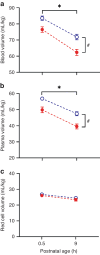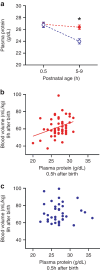Blood volume reduction due to rapid plasma loss after birth in preterm piglets
- PMID: 38773295
- PMCID: PMC11772245
- DOI: 10.1038/s41390-024-03252-x
Blood volume reduction due to rapid plasma loss after birth in preterm piglets
Abstract
Background: Understanding changes in blood volume after preterm birth is critical to preventing cardiovascular deterioration in preterm infants. The aims were to determine if blood volume is higher in preterm than term piglets and if blood volume changes in the hours after birth.
Methods: Paired blood volume measurements were conducted in preterm piglets (98/115d gestation, ~28wk gestation infant) at 0.5-5 h (n = 12), 0.5-9 h (n = 44) and 5-11 h (n = 7) after birth, and in a term cohort at 0.5-9 h (n = 40) while under intensive care.
Results: At 30 min after birth, blood volume was significantly lower in preterm piglets compared to term piglets. By 9 h after birth, blood volume had reduced by 18% in preterm piglets and 13% in term piglets. By 5-9 h after birth, preterm piglets had significantly lower blood volumes than at term (61 ± 10 vs. 76 ± 11 mL/kg).
Conclusions: In contrast to clinical resources, preterm piglets have a lower blood volume than at term. Substantial reductions in blood volume after birth leave some preterm piglets hypovolemic. If this also occurs in preterm infants, this may have important clinical consequences. Modern studies of blood volume changes after birth are essential for improving preterm outcomes.
Impact: Preterm piglets do not have a higher blood volume than their term counterparts, in contrast to current clinical estimates. Rapid reduction in blood volume after birth leads to hypovolemia in some preterm piglets. There is a critical need to understand blood volume changes after birth in preterm infants in order to improve clinical management of blood volume.
© 2024. The Author(s).
Conflict of interest statement
Competing interests: The authors have no conflicts of interest to declare. Patient consent: Patient consent was not required.
Figures




Similar articles
-
Reduced blood volume decreases cerebral blood flow in preterm piglets.J Physiol. 2018 Dec;596(23):6033-6041. doi: 10.1113/JP275583. Epub 2018 Jul 2. J Physiol. 2018. PMID: 29917228 Free PMC article.
-
Red cell infusion but not saline is effective for volume expansion in preterm piglets.Pediatr Res. 2023 Jul;94(1):112-118. doi: 10.1038/s41390-022-02403-2. Epub 2022 Dec 12. Pediatr Res. 2023. PMID: 36509847
-
[Impact of probiotics on the lung development of Bama minipig after premature birth].Zhonghua Er Ke Za Zhi. 2022 Apr 2;60(4):297-301. doi: 10.3760/cma.j.cn112140-20211231-01096. Zhonghua Er Ke Za Zhi. 2022. PMID: 35385933 Chinese.
-
Omega-3 fatty acid addition during pregnancy.Cochrane Database Syst Rev. 2018 Nov 15;11(11):CD003402. doi: 10.1002/14651858.CD003402.pub3. Cochrane Database Syst Rev. 2018. PMID: 30480773 Free PMC article.
-
Immediate Care for Common Conditions in Term and Preterm Neonates: The Evidence.Neonatology. 2025;122(Suppl 1):106-128. doi: 10.1159/000541037. Epub 2024 Nov 12. Neonatology. 2025. PMID: 39532078 Free PMC article. Review.
Cited by
-
Maternal immunity and African swine fever virus: understanding the limits of passive protection.Front Immunol. 2025 Jul 25;16:1593820. doi: 10.3389/fimmu.2025.1593820. eCollection 2025. Front Immunol. 2025. PMID: 40787441 Free PMC article.
References
-
- Doyle, L. W. Evaluation of neonatal intensive care for extremely-low-birth-weight infants. Semin. Fetal Neonatal Med.11, 139–145 (2006). - PubMed
-
- Batton, B. et al. Blood pressure, anti-hypotensive therapy, and neurodevelopment in extremely preterm infants. J. Pediatrics154, 351–357 (2009). - PubMed
-
- Osborn, D. A. & Evans, N. J. Early volume expansion for prevention of morbidity and mortality in very preterm infants. Cochrane Database Syst. Rev.4, CD002055 (2001). - PubMed
-
- Saigal, S., O’Neill, A., Surainder, Y., Chua, L. B. & Usher, R. Placental transfusion and hyperbilirubinemia in the premature. Pediatrics49, 406–419 (1972). - PubMed
MeSH terms
LinkOut - more resources
Full Text Sources

